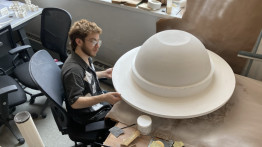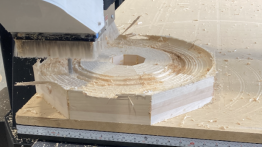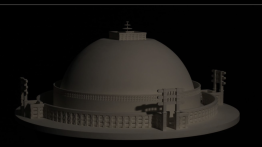Cooper Students Build Model for Met Exhibit on Early Buddhism
POSTED ON: July 18, 2023
Tree & Serpent: Early Buddhist Art in India 200 BCE–400 BCE, a Metropolitan Museum of Art exhibition that opened on July 21, features a model made by students and recent graduates of The Irwin S. Chanin School of Architecture. The show tells the story of the origins of Buddhism and Buddhist art and architecture, so the students were charged with building a model of a stupa, an essential architectural monument of Buddhism.
The students—Alice Meng AR'24, Dov Diamond AR'23, Sam Dobens AR'23, and San Simeon Koizumi AR'23—built the model under the direction of James Lowder, an assistant professor, with input from the Met's John Guy, curator of Tree and Serpent, and Mortimer Lebigre, graphic designer. Built of wood and 3D resin prints, the stupa sits at the center of the exhibition gallery. The group milled the base, drum, and dome on the CNC router at Cooper and assembled the stupa in layers. They constructed the railings and gates from 3D resin prints made in Cooper's The IDC Foundation Art, Architecture, Construction, and Engineering (AACE) Lab. The wood was rough sanded to shape, and then finished with numerous layers of modeling paste to remove any surface imperfections, further sanded, until the entire model was treated with a final coat of white paint. Approximately 15-inches tall and 36 inches in diameter, the model was built at a scale of 3/16-inch to one foot.
Though generally based on the Great Stupa at Sanchi in central India, the students' model is a more generalized version of the building type meant to show all its essential elements: a dome-shaped mass surrounded by a low wall with gates at the four cardinal points. The structure represents the life of the Buddha, the path to enlightenment, and the dome of heaven. With a railed terrace for the faithful to circumambulate, the stupa is topped with a tripartite sculpture called a chattra, which represents three aspects of Buddhism—the Buddha, the doctrine, and the community.
Stupas include detailed carvings telling the story of the Buddha, but the students' model could not include that aspect of the stupa. San Simeon explained, "We chose to simplify the ornamental detail significantly in part because of the scale of our model relative to the scale of detailing present on the built structures. The detail we chose to express was limited to slight reliefs, lips, proud edges. It was less about imagery and more about using the scale of the model to our advantage and being able to capture shadows and edges in a way that would represent a high level of detail without having to actually model it."
As a native New Yorker, he added, he's thrilled to be included in an exhibition at one the city's premier institutions.
Photos by San Simeon Koizumi AR'23









